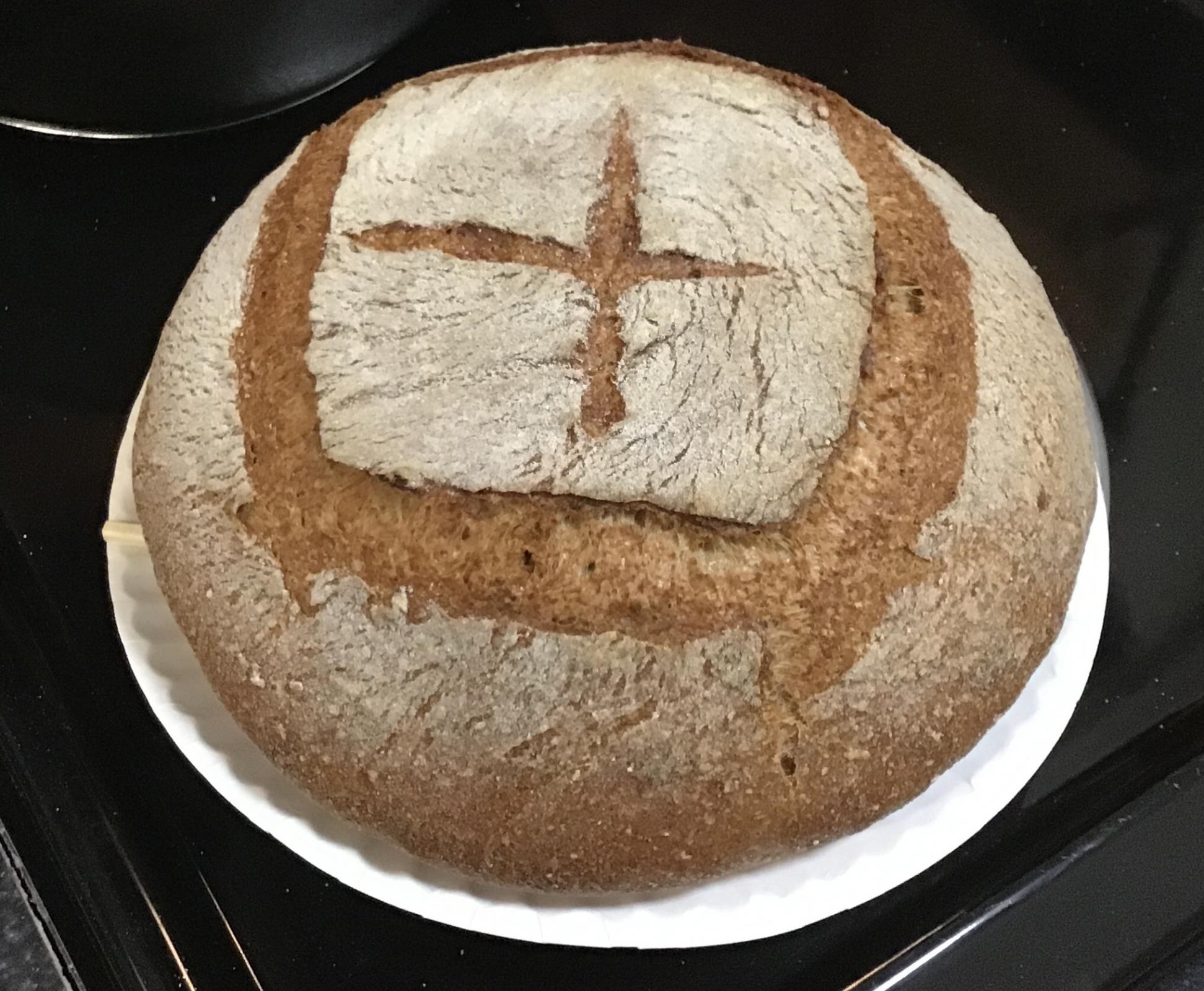Feb. 19, 2022. 87th bake.
Goals: A boule with 500+ grams of flour to fit in the deep pot of a Lodge 3.2 qt combo cooker, and to fit the baked loaf in a one gallon plastic zipper-seal bag. Mostly home milled, but also use up some store-bought flours such as semolina and two kinds of durum. Mostly commercial yeast, but also use up a chunk of low hydration rye starter that I had set aside but didn't use as expected.
- 25 g cracked coarse rye meal, from my 3-roller hand-cranked Shule brand mill.
- 25 g coarse rye flour, "Vitamixed" after cracking as above.
- 25 g coarse flour, hard red winter wheat, Vitamixed as above.
- 300 g Prairie Gold hard white spring wheat flour, Vitamixed as above.
- 37 g store-bought gritty semolina, from Patel Brothers.
- 10 g Sharbati whole grain wheat flour. Last of bag.
- 50 g Gold Medal bread flour.
- 10 g old fashioned rolled oats.
- 25 g roller-milled whole grain durum, Sher Brar brand, "Fiber Wala."
- 25 g roller-milled durum atta, Golden Temple red bag. This is mostly refined flour, with some bran that the miller added back in.
- 2.5 tsp bread spice. (Fennel, anise, coriander, caraway -- roasted whole, then ground. Measured after it's ground.)
- 1/2 tsp whole dry caraway seed.
- 425 g bottled spring water.
- Finished mixing above at 12:35 pm.
At 2:10 pm, mixed in:
- 6 g of moist pasty gur/jaggery, not the chunky kind.
- 1/2 tsp of instant yeast with expire date of Nov. 2019, last of jar.
- 1/4 tsp of instsnt yeast with expire date of Oct. 2020, just opened.
- 32 g water.
- approx 27 g of 50% hydration rye starter. 18 g flour: 9 g water.
- Did some kneading up front.
Hydration plan:
438 g of whole grains @ 90% = 394 g water.
112 g of refined grains @ 62% = 69 g water. 463 g total water.
Total water added was 466 g.
Did several knead-and-turns during bulk ferment.
At 3:54 pm it finally felt like a cohesive and properly hydrated "dough".
I forgot to note time when dough was folded, shaped, and put in 8" I.D. (8.6" O.D.) lined and dusted (rice flour and bread flour) banneton, and after a few minutes then in fridge.
PRE-HEAT: Oven, dutch-oven, and a baking stone were pre-heated to 470 F, then gave it another 20 minutes for stone and dutch oven to come up to temp. Baking stone was on the rack at the lowest position. Dutch oven on a rack 2 positions up.
While it was in banneton, base (facing up) of boule was dusted with cornmeal. Then covered with a round piece of parchment paper. Hot dutch oven pot was inverted and placed over it. They were then flipped over to load the dough into the pot. The dusting flour was brushed off and the dough scored in a # pattern. The skin was a bit loose, so the scores were sloppy. The dough deflated somewhat upon scoring.
Total ferment/proof was from 2:10 to 5:47, only 3 hours 37 minutes.
Started bake at 5:47 pm. Put the combo cooker in the oven and turned thermostat down to 450 F.
Baked, covered, 450 F, 15 minutes.
Baked, covered, 400 F, 15 minutes.
Baked, uncovered, 400 F, 20 minutes. Good oven-spring.
Finished @ 6:37 pm, 209 F internal temp. Bottom thumps well.
I let the boule rest/cool for about 90 minutes covered with just a paper towel. Then it was placed in a 1 gallon zipper seal plastic bag, in which it barely fit. I hope to resist the temptation to try some until 24 hours after baking.





